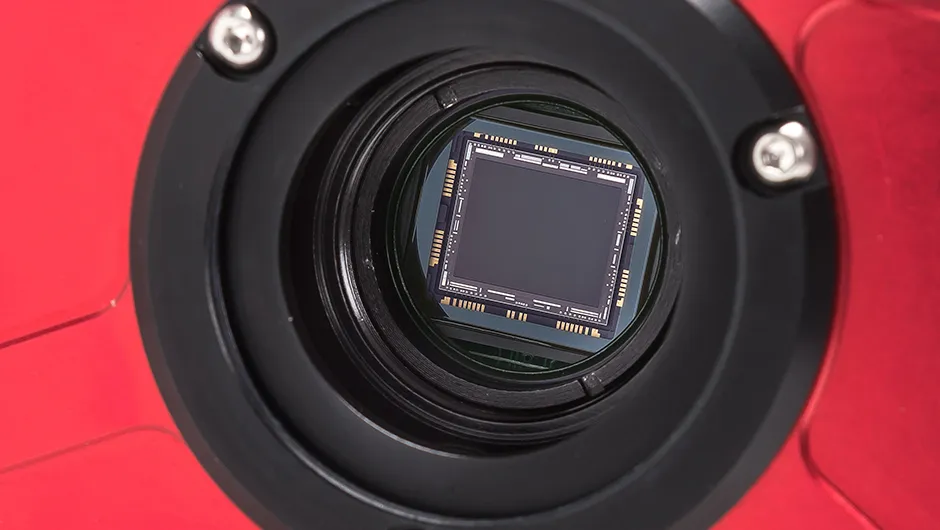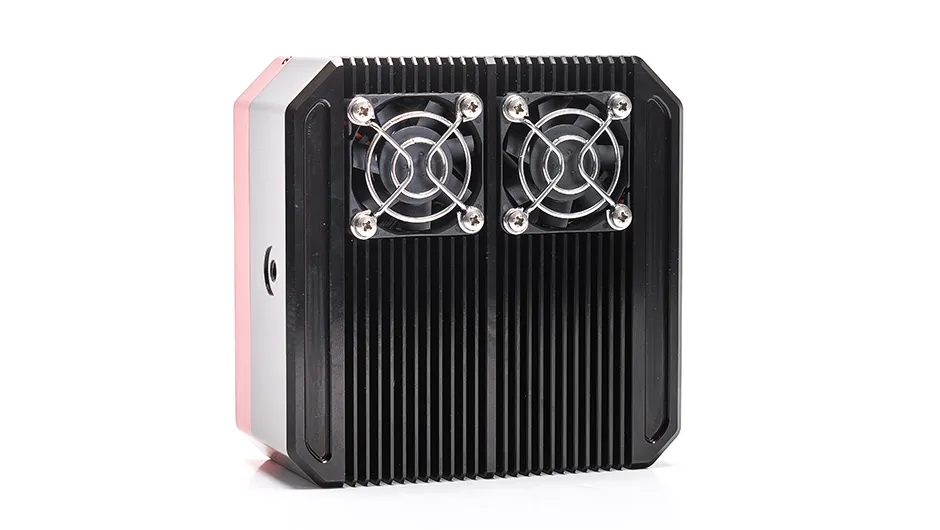Price: £2336.00
Weight: 900g
Supplier: Atik Cameras
Telephone: 01603 740397
Website: www.atik-cameras.com
Monochrome CCD cameras are a very popular choice for astro imagers as they provide a sensor that can be used in conjunction with a wide range of filters, which means you can capture all kinds of details in deep-sky objects.
Normally, the filters need to be housed in an external filter wheel, but the Atik One 6.0 dispenses with this by incorporating an automated wheel within its casing.
It is a very elegant solution.
To produce a colour image using a mono CCD camera, it is necessary to take a minimum of three sets of images: one with a red filter, one with a green filter and one with a blue filter. Combining these images produces an RGB colour image.
It is common to capture a fourth set of images at longer exposures using a ‘luminance’ filter to collect the structural detail at all wavelengths.
This luminance data is then overlaid with shorter-exposure colour data to produce an LRGB colour image.
While this is fine in theory, manually replacing each filter in turn is fraught with difficulty, so it is an absolute joy to have a built-in filter wheel that rotates to present each filter to the sensor in turn, under software control.
The Atik One is very compact, measuring just 120mm square by 58mm deep, and its attractive finish and chamfered corners give it a solid, quality feel.
Included in the printed retail box are a multi- product installation manual, CD of software and drivers, 12V cigar lighter cable, USB cable, 2-inch nosepiece, Allen keys and a tool to insert filters into the internal filter wheel.
The power cable’s plug connects with a reassuring click – there is no need to worry about it becoming dislodged mid-session.

A matter of control
Installing the software and drivers was very straightforward.
We tested the camera with both the simple but excellent Artemis Capture software supplied on the CD and our own version of MaxIm DL.
Drivers specific to MaxIm DL, CCDSoft and AstroArt are included on the CD.
However, the filter wheel itself can only be controlled using ASCOM when using any of the above programs.
As such, we exclusively used ASCOM to control both the camera and filter wheel during the review.
Although Sony CCD sensors are renowned for their low thermal noise, it is still necessary to keep them cool.
We set the cooling temperature to 20°C below ambient; with an air temperature at 12°C, it took just two minutes and 45 seconds to reach our goal temperature.
Test images captured both before and after cooling confirmed that it was working well.
There were no column defects visible in our 600-second dark frames and just a few hot pixels were visible.
We used these dark frames to remove thermal noise from the images captured by the camera.

We populated the filter wheel with a set of LRGB filters and placed a hydrogen-alpha (Ha) filter in the fifth slot, with a view to blending some Ha data into the red data collected from some emission nebulae.
Inserting the filters was a little fiddly, but once installed they were well protected and firmly held in place.
Unfortunately, appalling weather during the November review period thwarted our imaging plans but we captured Ha data on the rare occasions that we had a clearish sky.
The camera performed excellently, producing a field of view 1° and 24 arcminutes wide and 1° and 7 arcminutes deep when used in conjunction with a 4-inch refractor reduced to a focal length of 509mm.
This gave us an ample field to capture the lovely Eastern Veil in Cygnus (NGC 6992) using 10-minute exposures.
The Atik One 6.0 performed faultlessly during the review period, producing low noise images and capturing plenty of detail.
This camera will appeal to many imagers, but especially relative beginners because it is an ‘integrated’ solution that avoids some of the spacing issues that occur when using focal reducers and similar accessories.
As the sensor is larger than many ‘starter’ CCDs, it should also suit intermediate imagers who have cut their teeth on a small CCD sensor.

Accurate filter wheel
The Atik One 6.0 has an integrated filter wheel with a carousel mounted on axial needle roller bearings.
Incorporating a filter wheel into a CCD camera has some useful advantages.
External filter wheels add considerably to the backfocus of the system, causing spacing difficulties when also using focal reducers, field flatteners or coma correctors.
The integrated filter wheel here only adds 14mm to the depth of the camera, giving a total backfocus of 27mm.
As most correctors are designed for use with DSLR cameras – which have a total backfocus of nominally 55mm including their adaptor rings – this leaves a generous 28mm for the insertion of an off-axis guider as well, if required.
It also means you need fewer cables, as the power and USB leads for the filter wheel are shared with the camera.
The filter wheel has five 1.25-inch slots and it is vital that these are centred accurately in front of the sensor as each filter is chosen in turn.
During our bench testing, we found that the filters were very accurately positioned and repeatability was excellent.
CCD sensor
The Sony sensor is 12.5x10mm, yielding a 16mm diagonal. Each individual pixel is 4.544μm2, giving a total of six megapixels on the sensor surface.
Despite this generous size the camera uses 1.25-inch filters.
Set-Point Peltier cooling
It is important to keep the sensor as cool as possible to reduce the thermal noise produced during long exposures.
The Atik One 6.0 possesses a single-stage Peltier thermoelectric cooling system with twin external fans and set point cooling control; these can cool the sensor to as low as 38°C below the ambient temperature.
Alloy case
The camera’s case is beautifully machined from aluminium alloy block and the whole back panel comprises a heat sink to help with cooling. The case includes two camera tripod threads and a female T-threaded adaptor at the front that can be removed for the attachment of an optional off-axis guider.
Control and processing software
The supplied CD includes Artemis image capture software (pictured), which gives full control of the camera and allows you to schedule a sequence of multiple image capture routines.
Also included is the rather quirky image processing package Dawn, which can be used to calibrate, align and stack images.
Connections
The camera’s bottom panel houses a range of connections: a 12V input; 12V auxiliary output for external devices; USB 2.0B connection; and a USB hub connector for controlling additional devices, such as a guide camera.
Surprisingly, the functions of these ports are not labelled.
This review originally appeared in the February 2015 issue of BBC Sky at Night Magazine.
